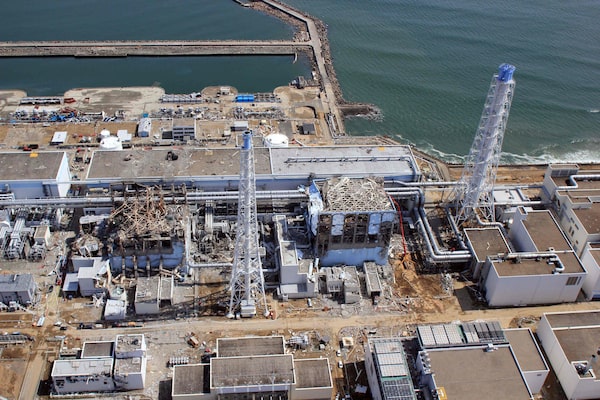
The Tokyo Electric Power Co. Fukushima Daiichi No.1 nuclear power plant, with the damaged fourth reactor, right, and the damaged third reactor, left, in the town of Okuma in Fukushima prefecture, following the earthquake and tsunami which hit the region on March 11, 2011.HANDOUT/AFP/Getty Images
Ten years ago next week, in the aftermath of a terrible natural disaster, Japan offered the world a valuable lesson about nuclear power and climate change. Unfortunately, it was not the lesson the world took from it.
The tsunami that tore through coastal Japanese cities in the wake of the Tohoku earthquake on March 11, 2011, was the most powerful tidal wave in three centuries. It killed more than 18,000 people – thousands are still listed as missing – left hundreds of thousands homeless and devastated the lives of countless families.
As that humanitarian crisis was just beginning, the world’s attention turned away from the larger tragedy and focused on the former coal-mining town of Okuma, in Fukushima prefecture, on Japan’s eastern coast. There, the tsunami had washed over the 40-year-old nuclear plant, flooded its basements and knocked out its backup power, causing the cores to melt down in three of its six reactors.
The meltdown, the ensuing mass evacuation and the lengthy, clumsy operation to stabilize the reactors became a global event that shaped the world’s perception of nuclear power.
The incident was, in every way, a worst-case scenario. The reactors – primitive General Electric boiling-water units with Mark I containment vessels, designed in the early 1960s to be cheaper than other reactors – are considered by many engineers to be the worst ever built. In 1972, shortly after the first Fukushima units came online, officials at the U.S. Atomic Energy Commission recommended the GE design be discontinued because its containment system was so badly flawed. No reactors with such weak containment have been built since the 1970s.
The Fukushima units were also built in the worst possible place: a tsunami-prone stretch of coast. In 1967, during their construction, the Tokyo Electric Power Co. (TEPCO) decided to save money by building them only 10 metres above sea level, not the 30 metres required in the design.
And the units were operated with astonishing incompetence. In 2012, a Japanese parliamentary panel concluded the nuclear disaster happened because TEPCO and its regulator had “failed to correctly develop the most basic safety requirements.”
So in short: This was a case in which the worst possible reactor, built in the worst possible place and operated by perhaps the least competent people was exposed to the worst possible seismic event.
And yet the death toll, in terms of acute radiation exposure, was zero. In 2018, one plant worker’s family won a lawsuit claiming his death by cancer had resulted from the disaster, although radiation scientists argued it was far more likely caused by his exposure to cigarette smoke. The evacuation itself caused more than 2,000 deaths, most involving the elderly and none related to radiation.
Long-term exposure to radiation might theoretically have raised the probability of cancer deaths in the region, but no such increase has yet been detected. The World Health Organization and academic researchers have concluded that the increased cancer risk near the reactor is either negligibly low or non-existent – the radiation blew out over the Pacific, where it dissipated quickly to non-detectable levels.
Amid all the tsunami and evacuation deaths, the reactor itself proved to be close to harmless.
But that wasn’t the lesson the world took from it. The chaos and anger coming from Japan created a sense that the meltdown had produced a deadly radiation event. For years afterward, implausible theories about radiation drifting across the Pacific to North America went unchecked in the media.
And we learned this erroneous lesson at exactly the wrong time. By 2011, we knew the largest single source of greenhouse gases contributing to climate change was the burning of fossil fuels to generate electricity. The most effective way to meet the target of limiting global warming to no more than two degrees is to convert the coal-fired generating plants in China, India and other countries to nuclear, as quickly as possible. Nuclear power is enormously expensive in the long term, but faced with a mounting climate catastrophe, such big investments now seem prudent.
At just the moment when governments should have been turning to nuclear, Fukushima and its resulting mass hysteria put the brakes on those plans. Two months after the disaster, German Chancellor Angela Merkel announced she would shut down all German nuclear plants by 2022 – leaving her country disproportionately dependent on coal for electricity. Other leaders more quietly cancelled their own countries’ plans.
Countries such as Canada should have spent the decade helping India and other less prosperous countries make the transition to nuclear and renewable power sources. Fukushima took such ideas off the agenda. Now, after 10 years of wildly exaggerated fears, it’s time to absorb the real and encouraging lesson of Fukushima.
 Doug Saunders
Doug Saunders